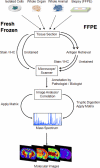Imaging of intact tissue sections: moving beyond the microscope
- PMID: 21632549
- PMCID: PMC3138310
- DOI: 10.1074/jbc.R111.225854
Imaging of intact tissue sections: moving beyond the microscope
Abstract
MALDI-imaging MS is a new molecular imaging technology for direct in situ analysis of thin tissue sections. Multiple analytes can be monitored simultaneously without prior knowledge of their identities and without the need for target-specific reagents such as antibodies. Imaging MS provides important insights into biological processes because the native distributions of molecules are minimally disturbed, and histological features remain intact throughout the analysis. A wide variety of molecules can be imaged, including proteins, peptides, lipids, drugs, and metabolites. Several specific examples are presented to highlight the utility of the technology.
Figures




Comment in
-
Thematic minireview series on biological applications of mass spectrometry.J Biol Chem. 2011 Jul 22;286(29):25417. doi: 10.1074/jbc.R111.266700. Epub 2011 Jun 1. J Biol Chem. 2011. PMID: 21632545 Free PMC article.
References
-
- Aerni H. R., Cornett D. S., Caprioli R. M. (2006) Anal. Chem. 78, 827–834 - PubMed
Publication types
MeSH terms
Substances
Grants and funding
LinkOut - more resources
Full Text Sources

